With sales expected to hit $3.5 trillion by 2024, the B2C marketplace is a rapidly expanding industry. This is high time to build a marketplace app of your own.
The industry is booming, the user base is responding well, and the marketplace is one of the world’s largest industries. This has attracted many businesses and start-ups to create a marketplace app of their own.
If you too want to develop a marketplace solution but don’t know how to, this blog is for you. Here, we will be looking at everything starting from the definition of the marketplace to how to build a marketplace app.
What is an Online Marketplace?
Before we dive in, let’s understand the basics of a marketplace.
A marketplace is a digital platform that brings together multiple sellers and buyers. You can think of it as a virtual shopping mall where you can find different products and services.
These platforms can handle transactions, payments and often shipping logistics. For example, Amazon, eBay & Etsy. These marketplaces offer convenience for shoppers by providing a huge selection in one place while giving sellers a broader reach for their products.
There is no doubt that online marketplaces have transformed the way we shop and do business. They’ve transformed the retail landscape, offering unparalleled convenience and access to a huge array of products.
From small businesses to global brands, marketplaces have become essential platforms for reaching customers worldwide increasing the demand to develop a marketplace app.
Online Marketplace vs eCommerce
eCommerce vs Marketplace has been a topic of discussion for a long time, especially in the context of fashion bags, continues to be a topic of discussion. One of the general confusion people have is how a Marketplace is different from an e-commerce platform or if they are the same.
Marketplaces and eCommerce are both platforms that are used by people to sell products or services online, but they operate differently.
An eCommerce store is owned and operated by a single entity, selling its products or services. It has full control over the product selection, pricing, branding, and customer experience. The increasing reliance on mobile devices for shopping has increased the growth in eCommerce app development, providing businesses the opportunity to reach and convert customers on the go.
In contrast, a marketplace acts as a digital intermediary, hosting multiple sellers who offer their products on the platform. It provides a platform for buyers to discover a wide range of products from different sellers & buy as per their choice.
With this table, you might get a better overview of Online Marketplace vs. e-commerce:
| Feature | Online Marketplace | eCommerce |
| Ownership | Multiple sellers | Single owner |
| Product Selection | Wide variety | Limited to the store’s inventory |
| Control | Marketplace platform | Store owner |
| Revenue Model | Commission on sales, listing fees | Product sales, subscriptions |
| Examples | Amazon, eBay, Etsy | Nike.com, Apple.com, Walmart.com |
With that being clear, let’s take a look at different types of online marketplaces that you can develop.
Types of Online Marketplace Apps
The marketplace landscape is varied and expansive. If you’re looking to build an online marketplace app, explore the different options available to you.
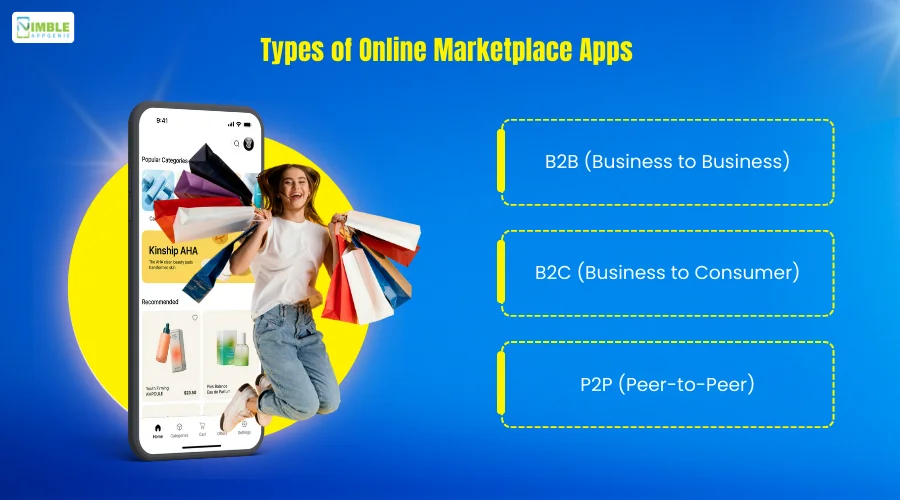
♦ B2B (Business to Business)
A B2B marketplace is a famous model.
These platforms cater to wholesale, manufacturing, and service-based interactions. They often involve complex negotiations, bulk orders, and specialized product listings.
Building a B2B app includes features like product catalogs, payment gateways for large transactions, and secure communication channels.
The growing popularity of B2B businesses is due to the rise of digital transformation, globalization, and supply chain complexities that give you more reasons to develop a marketplace app.
♦ B2C (Business to Consumer)
B2C Marketplaces facilitate sales between businesses and individual consumers.
These platforms focus on user experience, product discovery, and seamless checkout. Building a B2C app includes many amazing features like product search, personalized recommendation, shopping cart functionality, secure payment integration, and order tracking.
Make sure to consult with a talented mobile app development company to get features that make your marketplace a hit in the market.
♦ P2P (Peer-to-Peer)
P2P marketplaces enable individuals to transact directly.
They often revolve around sharing economy models like renting accommodations (Airbnb), sharing rides, or selling used items (eBay).
It requires a trust-building mechanism, user ratings, secure payment processing, and dispute resolution systems.
With that, get to know if is it worth it to develop an online marketplace app, let’s check out the thriving market.
Stats about Growing Online Marketplace Apps
Global retail sales surged to an impressive $5.8 trillion in 2023 and are projected to skyrocket to over $8 trillion by 2027, marking a staggering 39% growth showing no signs of slowing down as illustrated in the graph below:
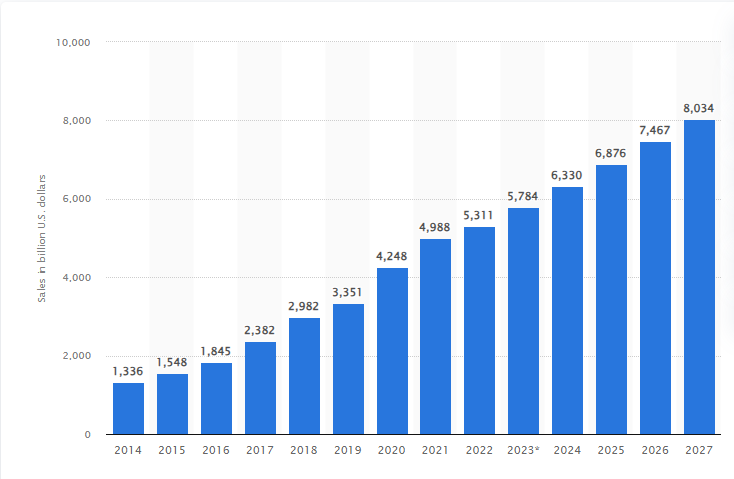
The staggering growth highlights a golden opportunity for investors to create an online marketplace app. With consumers increasingly shifting their shopping habits to digital platforms, there’s massive potential to capture a significant market share.
Why Build A Marketplace App?
If you want to understand why create a marketplace app, we are sharing how it can be beneficial for you and your business, let’s delve into the benefits of developing a marketplace app:
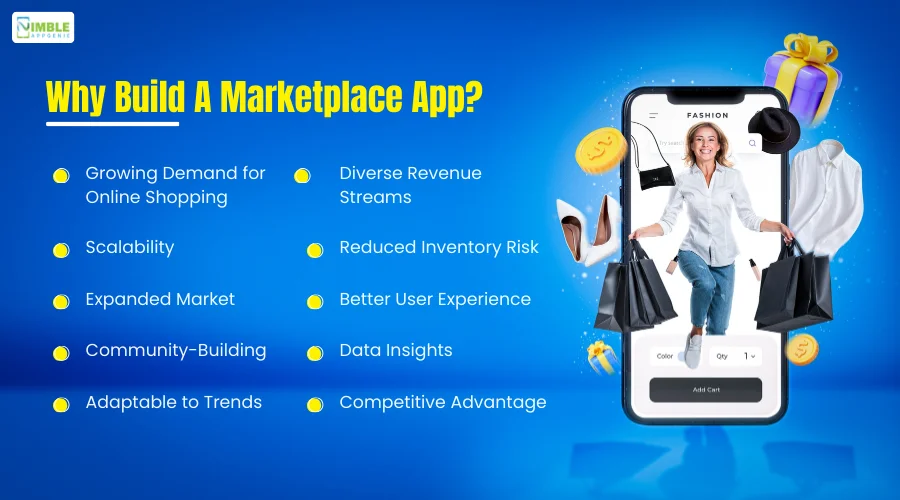
-
Growing Demand for Online Shopping
Shopping online, convenience and the range of goods leads to international growth in sales. According to eMarketer, global e-commerce sales are predicted to exceed billions. This growth offers a huge opportunity for marketplaces to grasp some of this market.
-
Diverse Revenue Streams
Online markets have several business models. You can make money selling goods through commissions, fees for listings or subscriptions, and also advertising-which gives everyone the chance to create a sustainable income flow of their own choosing.
-
Scalability
With a well-designed platform, you can increase the number of users and providers without the need for physical expansion. Online marketplaces can grow quickly and offer a customer base more than conventional retail methods.
-
Reduced Inventory Risk
In a marketplace model, you do not hold the product yourself. You act as a facilitator for buying and selling transactions between sellers of goods -thus reducing risks associated with keeping large amounts of inventory and freeing up more funds for other aspects of business development.
-
Expanded Market
Goods available on online markets can be seen by audiences around the world.
By eliminating geographical barriers, you can bring users and providers from diverse regions onto your market-expanding its reach and potential growth zones making it beneficial to build a marketplace app.
-
Better User Experience
A marketplace that is properly designed can give users greater ease in finding what they want on just one platform.
For instance: Features like powerful search filters, user reviews, and personalized recommendations for future purchases help enhance the shopping experience and make customers happier instead of more difficult to please.
-
Community-Building
Online markets often tend to bring buyers and sellers into communities of mutual interest and needs.
By providing a forum for feedback, interactions, and exchange, you give places where people doing business with you can begin to trust each other.
-
Data Insights
Marketplace apps produce invaluable data about user behavior, product preferences, and popular trends. This can be used to make solid business decisions, improve one’s site platform, and score more marketing hits where it matters the needs of the consumers.
-
Adaptable to Trends
Online markets can be tempered with changing consumer preferences, making it easy to introduce new features, adjust your product offerings, and respond as customer demands see fit. Thus you keep your platform alive and competitive.
-
Competitive Advantage
Creating a marketplace app gives you a competitive advantage.
By identifying the holes in existing platforms and coming up with creative solutions, you will be able to cultivate a diehard user base for your market.
Once your marketplace enters the field this way, it will clearly be in charge of it.
Talking about existing platforms, let’s take a look at famous marketplaces and learn from the successes of these established marketplaces to get encouraged to make an online marketplace app.
Famous Marketplaces Apps: Get Inspired
There are several marketplace apps present in the market. You can take inspiration from these apps and understand their strengths, weaknesses, and user preferences to create an online marketplace app.
Let’s get to know them:
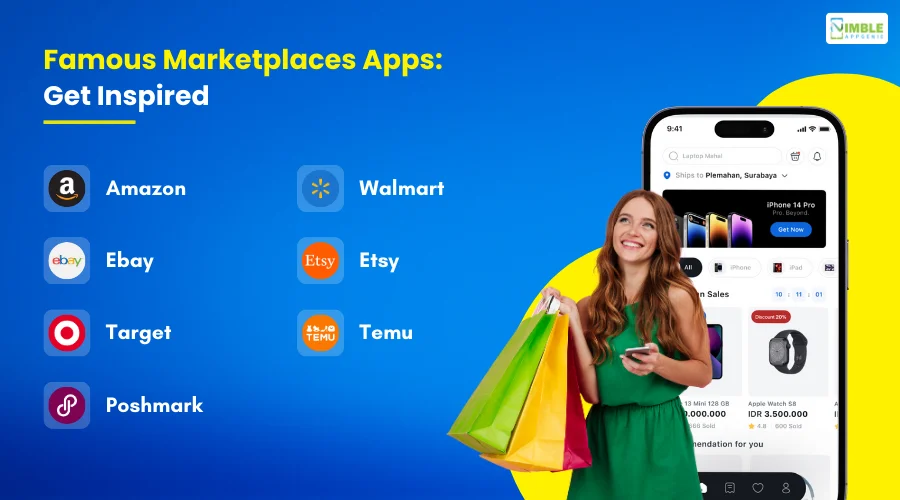
► Amazon
Let’s start with one of the top marketplaces out there “Amazon”.
What started as an online Bookstore, it now expanded into a huge platform offering an incomparable range of products. Its success pivots on a customer-centric approach, prioritizing fast shipping and vast product selection.
Moreover, its incorporation of cloud services (AWS) and digital content has solidified its position as a tech industry leader.
To create an app like Amazon, you need robust infrastructure, including fulfillment centers and logistics, to ensure efficient order processing and delivery.
► Walmart
Walmart had been a behemoth of brick & mortar retail but it was pivoted as the #1 online marketplace.
This app with its deep physical store footprint and strong brand-name recognition delivers a range of varieties at attractive price points.
Its web offers the best shopping experience with an extensive browsing feature, allowing you to buy online and directly in-store pickup! Walmart has built a great marketplace by using its core competencies of everyday low prices and customer satisfaction.
This not only attracts users but also investors to make a marketplace like Walmart and imitate its success.
► eBay
As one of the first major marketplaces in existence, eBay is also famous as a top eCommerce platform worldwide.
It is the most extensive digital marketplace in which individuals and companies can purchase, and sell products of all types.
Its auction-style format and massive selection of products have helped eBay become a leader in the online shopping world. And over the years it has grown, adding buy-it-now type listings and additional features to give buyers a better experience.
► Etsy
You may even be familiar with an active online market called, Etsy. It has a good place in the market thanks to the public targeted for it (sellers with creativity, buyers of that).
What sets Etsy apart is its special type of Etsy business model that assists individual craftspeople and provides worldwide reach to them.
It even supports production methods like print-on-demand, where sellers can collaborate with third-party suppliers to create custom items only after an order is placed. This flexibility empowers creators to expand their product offerings, such as personalized t-shirts or mugs, without the burden of managing inventory or production themselves.
With more and more competition arising each day in the form of Etsy alternatives & competitors, its robust brand recognition plus devoted client base have made it a key player among other marketplaces.
► Target
Target is a well-known retailer that has made its mark online in the world of online marketplaces.
Famous for its sleek and user-friendly interface, Target has packed a wide range of items in order to pay there at the online packages too – Boutique offerings, Clothes companies, Homewares, Tech components & more.
Target’s marketplace has created an environment where customer experience is paramount, winning many shoppers over in the process — combining the modern convenience of a marketplace with physical store brand clout.
► Temu
Over the past several years, Temu has become one of the fastest-growing marketplaces that frequently offer deals on several products at prices lower than you will find in other places.
It is becoming popular due to the direct2consumer model they have and manufacturer partnerships that sell their product.
By maintaining a superbly affordable and making its vast range of products available, Temu has shaken the marketplace world by attracting millions to its platform within one year.
To create an app like Temu, it’s important to understand the dynamics of fast fashion, and efficient logistics to replicate its disruptive pricing model.
► Poshmark
An example here is Poshmark, the online fashion and accessory marketplace. It has created a unique online community with social shopping features that allow users to discover, share, and shop in each other’s closets.
Its easy-to-use interface, virtual closets, and shipping integration have helped push Poshmark forward in the reselling world.
Their platform has created a pretty solid community of people interested in fashion and is known as one the best places to buy budget-friendly secondhand items. This popularity has made many people look for ways to build an app like Poshmark.
Features to Integrate to Build a Marketplace App
If you want to create a marketplace app, incorporating the right features is paramount.
Let’s explore the core functionalities that can transform your app into a buyer and seller haven.
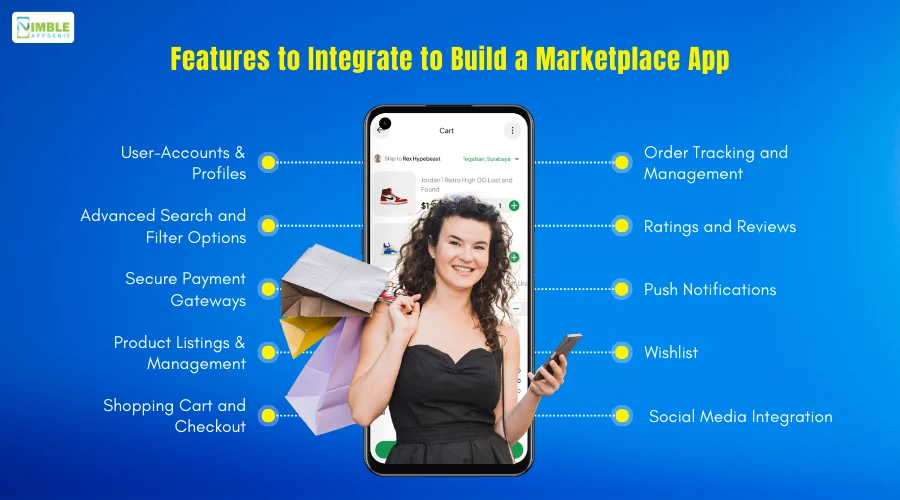
1. User-Accounts & Profiles
This is essential for a smooth user experience. A well-designed marketplace always comes with strong user accounts and profiles. This helps the user to manage Personal Data, Track Order History, Save Preferences, and engage with the platform easily.
A complete profile not only increases user experience but also helps in personalized recommendations fostering engagement and loyalty.
A positive user journey requires clear navigation, logical organization, and consistent design system principles a necessity to create a marketplace app that becomes a huge hit.
2. Advanced Search and Filter Options
Good product discovery depends on rich search and filter capabilities.
This is why customers must be able to easily locate relative products by using search parameters like keywords, categories, brands prices, etc.
Filters such as color, size, or material refine the search further and reflect a better user experience.
3. Secure Payment Gateways
Keeping User Data Safe Access to reliable, safe payment gateways will be critical in restoring customer faith.
So, Payment Gateways Integration has to be standardized and should support multiple payment types for various consumer needs.
4. Product Listings & Management
Product listings are what draw potential buyers to your product so they must be designed strategically.
It’s of importance to have detailed information on products, i.e., high-quality images with meaningful descriptions and specifications along with prices.
Easy-to-use seller dashboard enables merchants to manage inventory, track sales, and communicate with customers.
5. Shopping Cart and Checkout
Make sure to test your shopping cart well as it can make or break conversions.
A frictionless way for users to quickly add and remove things from the cart, if all went well before the user ever checks out.
Then comes, a safe payment process, and a standardized order confirmation is mandatory for a smooth checkout.
6. Order Tracking and Management
Let customers know where their purchase stands, thanks to real-time order tracking.
Handling of Shipping, Returns, and Refunds — for seamless order management, the shipping should be fast and accurate otherwise returns will start building up which would lead to unhappy customers leading to dissatisfaction.
If you can communicate well and give information at a suitable time, then of course it will create long-term satisfaction for customers.
7. Ratings and Reviews
Ratings and Reviews have become part of the purchase funnel.
A strong review system not only generates user content but also establishes a sense of trust in it. In addition, feedback is very useful for sellers to develop their offer and it also helps fellow buyers to make the right decision.
8. Push Notifications
Drive higher user engagement with personalized push notifications services.
The ability to send notices immediately regarding updates on purchases, promotions, and personalized suggestions aids app usage grow sales.
9. Wishlist
Users can save products that they are interested in to purchase later.
This leads to a more efficient system for user navigability and interested item tracking. It also entices visitors to come back and increases the chances of conversion.
10. Social Media Integration
No great way to get around this: social media integration is key for driving visibility and engagement in your marketplace.
Facebook and Instagram seamlessly integrated — Enable your shoppers to share the newest collection, like exclusive sales, or view a new line of brand merchandise via social media.
What this does is grow your audience, build a great community of people, and introduce them to you and your app.
Process to Create an Online Marketplace App
One of the most asked questions is “How to create an Online Marketplace App?”
It’s a step-by-step app development process that guides you from conceptualization to launch. Without any further ado, let’s get to know about it all:
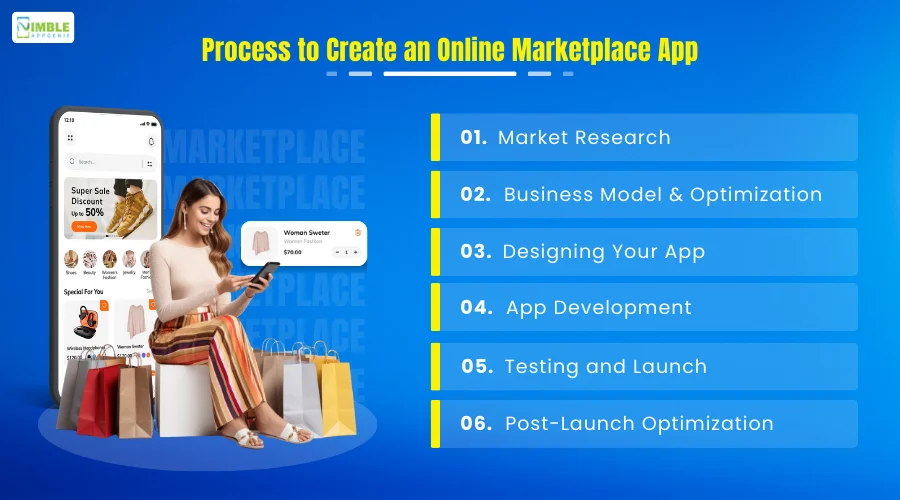
Step 1: Market Research
First thing first, let’s start with proper market research.
If you want to create an online marketplace app, then you need to know about the target audience and competitors.
Through detailed research, you can gain an understanding of your customer needs, preferences, and behaviors; you can identify a profitable niche, refine your value proposition, and make better decisions throughout the development process.
Essentially, it’s important to have market research to validate your idea and develop a better strategy.
Step 2: Business Model and Optimization
A well-defined business model is important to be the best platform.
If you want to create an online marketplace, we suggest you determine whether your platform will be B2B, B2C, or C2C.
Other than that, you should also figure out different monetization strategies like commission fees, subscription plans, advertising, or a combination. Clearly outline the value proposition for both buyers and sellers to attract and retain users.
Step 3: Designing Your App
Creating a visually stimulating and easy-to-navigate interface is at the center of designing any marketplace app.
This takes the form of visually styling everything, creating user-friendly navigation menu items, and laying out product displays effectively.
Focus on your UI/UX – if your website is easy to navigate, products are simple to find and checkout is a breeze that puts you way ahead of the competition.
Good design improves customer happiness, engagement rates, and consequently conversions. This harmony of functions with aesthetics is what makes for a truly great marketplace experience.
Step 4: App Development
Now, this is the phase to build your online marketplace app.
This includes developing features like user profiles, search functionality, product listings, shopping carts, and payment gateways. In addition to that, developers write code to bring your app to a solution.
Make sure to implement the best security measures including encryption, authentication, and authorization to ensure the security of the app.
Step 5: Testing and Launch
One very important thing to do before the release is to carry out extensive testing.
Focus on bug tracking and resolution, performance improvement, as well integration with users. Then, you can publish to app stores with good descriptions and graphics.
Step 6: Post-Launch Optimization
And like all things that matter, it’s rarely a straight line — a continuous improvement for long-term success.
Focus on metrics, collect feedback, and iterate your platform. Based on the users’ feedback, make changes to your app to keep the platform relevant and functional.
With this out of the way, let’s get to know about the challenges that you can face while making an online marketplace app.
Online Marketplace App Development Challenges
Building an online marketplace comes with its own set of challenges. From technical hurdles to market competition, there are several factors that can affect your whole development process.
Let’s get to know about all those challenges that need your prior attention:
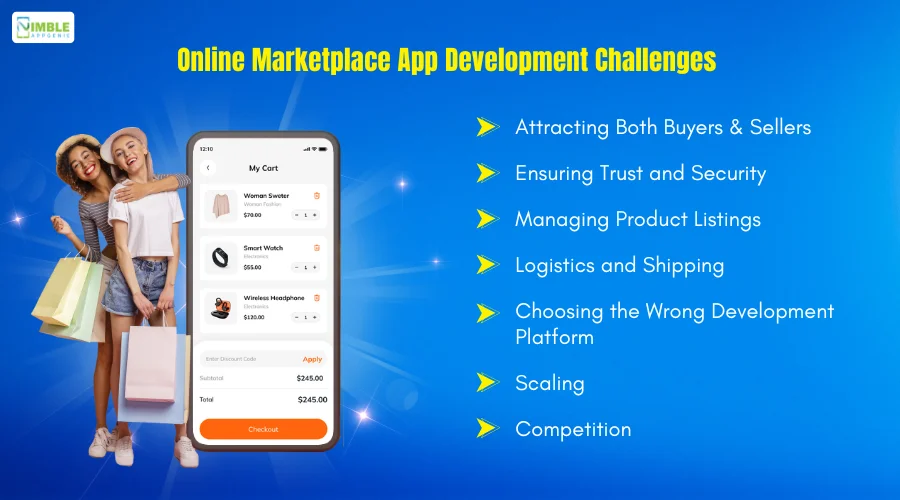
-
Attracting Both Buyers and Sellers
The most difficult problem lies in the first experience – attracting early users to both the seller and buyer sides of the market. As the buyer does not want to be a member of the platform without products and the seller is afraid of a lack of buyers.
To solve this problem, you need to apply good marketing, offer incentives that will attract the target audience to the platform, work on user-friendly design, and provide value to people from the proposal.
-
Ensuring Trust and Security
With the increasing issues of cyber-attack, it seems like ensuring data and app security should be a top concern for you.
Building trust in the platform is essential in any market. This means you have to protect the data of users, work on honest and fair transactions, and reliable measures to prevent fraud.
-
Managing Product Listings
Keeping control over the information that is provided by buyers hugely takes a lot of time and work, including descriptions, photography, and pricing.
Specific control problems are counterfeiting and piracy will allow users to trust your app.
-
Logistics and Shipping
The successful delivery of products is the key to a satisfied customer.
This includes cooperation with carriers, completion of returns, but also live tracking. As you increase the number of orders, you must ensure the scale of functions.
-
Choosing the Wrong Development Platform
Choosing the wrong development platform can seriously obstruct online marketplace creation.
Performance issues, increased costs, and delayed time-to-market can adversely affect an otherwise viable solution ultimately failing due to the wrong platform.
This problem can be avoided by doing a comprehensive evaluation of the platform’s capabilities and proper alignment with business objectives.
-
Scaling
As your business and customer base expand, the need for a scalable platform becomes increasingly critical. Scaling involves handling increased user traffic, managing larger datasets, and ensuring consistent performance.
Inadequate scalability can lead to system slowdowns, and crashes, hindering business growth and reputation.
-
Competition
As you know, the marketplace app market is very competitive. It will always be necessary to keep customer requirements in order to be in front of the competition.
With so many options available in the market, attracting users to the platform can be a daunting task.
Standing out from the crowd requires innovative marketing strategies, compelling value propositions, and top-notch features that can set you apart.
Cost to Develop an Online Marketplace App
Do you want to know “How much it costs to build an Online Marketplace App?”
The cost to develop an app can change based on several factors and project complexity. But, on average the marketplace app development cost can range from $30,000 to $200,000+.
As of now, let’s take a look at the cost to develop a marketplace:
| Marketplace Type | Core Features | Estimated Cost |
| Basic Marketplace | Product listing, search, user profiles, shopping cart, payment gateway integration | $30,000 – $60,000 |
| Mid-Sized Marketplace | Basic features + advanced search, product reviews, seller ratings, mobile app (basic), analytics | $60,000 – $120,000 |
| Enterprise Marketplace | Mid-sized features + multiple payment options, order management, inventory management, marketing tools, advanced analytics, mobile app (advanced) | $120,000 – $200,000 |
Nimble AppGenie: Your Partner in Creating a Marketplace App
Marketplaces have revolutionized shopping, offering unparalleled convenience and choice.
A successful marketplace requires seamless user experience, robust technology, and effective marketing, for which you need experts on your project. Nimble AppGenie– the Best Online Marketplace App Development Company can be a partner in this journey.
From conceptualization to launch & beyond, we provide support in features, design, development, to maintenance, ensuring your marketplace stands out in the competitive landscape.
If you are ready to take steps forward, send us your requirements to get started.
Conclusion
The marketplace industry is booming, offering a lucrative opportunity for businesses. This guide explored the different types of marketplaces (B2B, B2C, P2P) and their advantages. We highlighted the key features of a successful marketplace app, from user-friendly interfaces to robust payment gateways.
Developing a marketplace app comes with its challenges, but with careful planning and a reliable development partner like Nimble AppGenie, you can overcome them. They can guide you through every step, from market research to post-launch optimization, ensuring your marketplace thrives in the competitive landscape.
FAQs
The cost to develop an online marketplace app varies significantly based on factors such as:
- Marketplace type: Basic, mid-sized, or enterprise
- Core features: Product listing, search, payment gateway, mobile app, etc.
- Platform choice: Custom development or pre-built solutions
- Design complexity: Simple or complex design
- Development team location: Onshore, offshore, or nearshore
Generally, costs can range from $30,000 to $200,000 or more.
Development time also depends on different factors. A basic marketplace app might take several months, while a complex enterprise marketplace could take a year or more.
Building a successful online marketplace app comes with challenges:
- Attracting buyers and sellers: Creating a balanced ecosystem is crucial.
- Ensuring trust and security: Protecting user data and preventing fraud is essential.
- Managing product listings: Maintaining quality and consistency is time-consuming.
- Logistics and shipping: Efficient delivery is crucial for customer satisfaction.
- Competition: Standing out in a crowded market requires differentiation.
Some of the key features include:
- User-friendly interface
- Advanced search and filter options
- Secure payment gateways
- Product listings and management
- Shopping cart and checkout
- Order tracking and management
- Ratings and reviews
- Push notifications
- Wishlist
- Multiple payment options
Common monetization strategies include:
- Transaction fees: Charging a commission on each sale.
- Listing fees: Charging sellers for listing products.
- Subscription fees: Offering premium features for a subscription fee.
- Advertising: Displaying ads to generate revenue.
- Data monetization: Leveraging user data for insights and targeted marketing.

Niketan Sharma is the CTO of Nimble AppGenie, a prominent website and mobile app development company in the USA that is delivering excellence with a commitment to boosting business growth & maximizing customer satisfaction. He is a highly motivated individual who helps SMEs and startups grow in this dynamic market with the latest technology and innovation.
Table of Contents




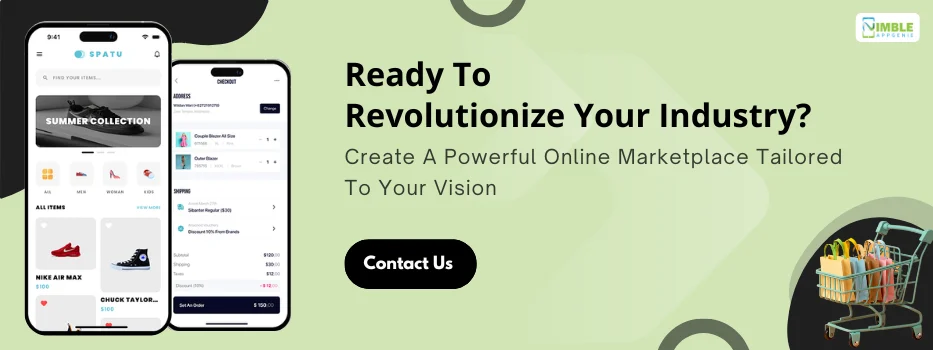
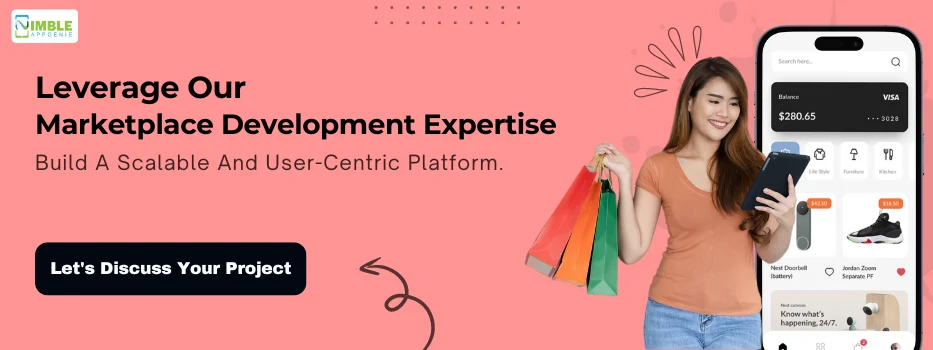
No Comments
Comments are closed.